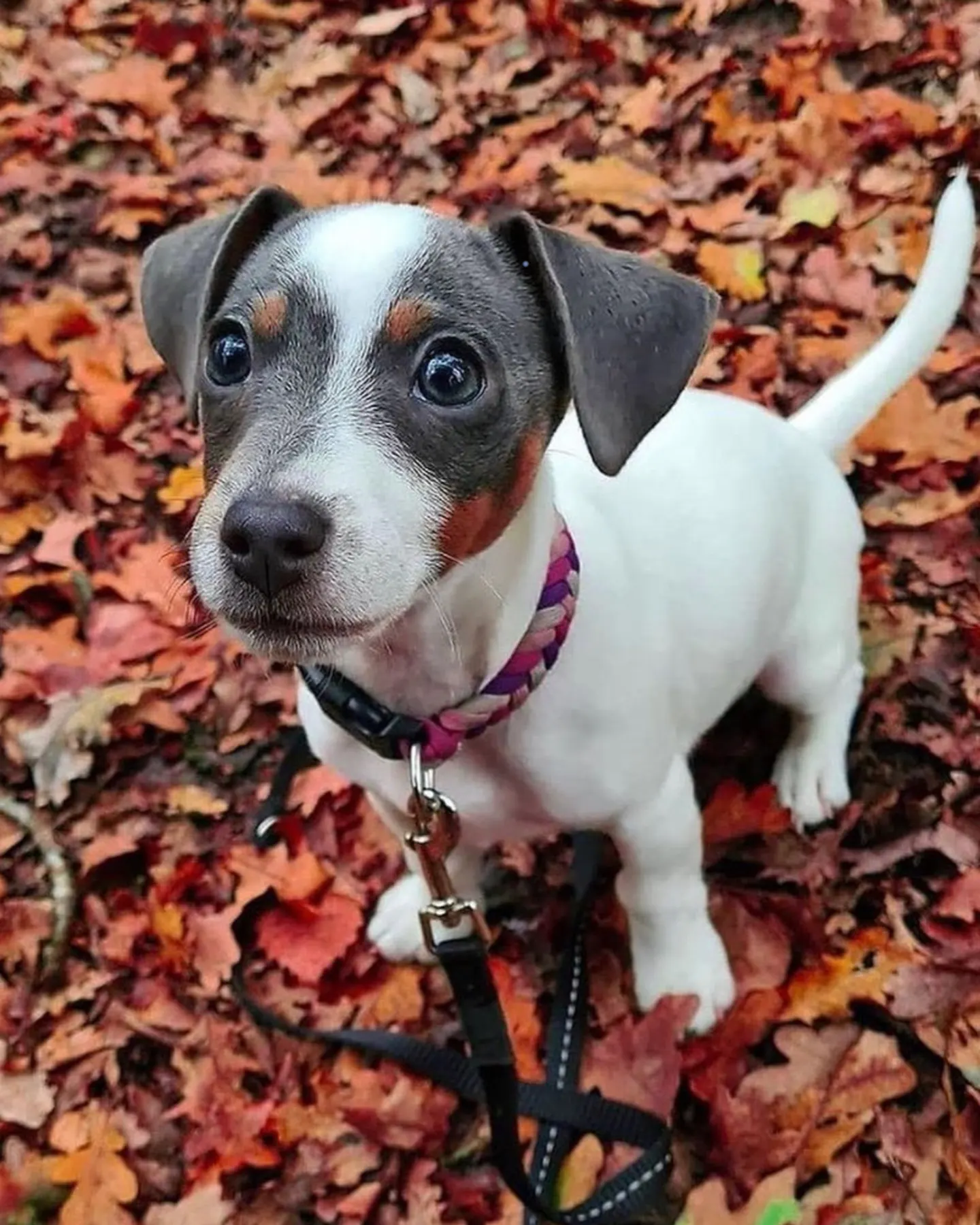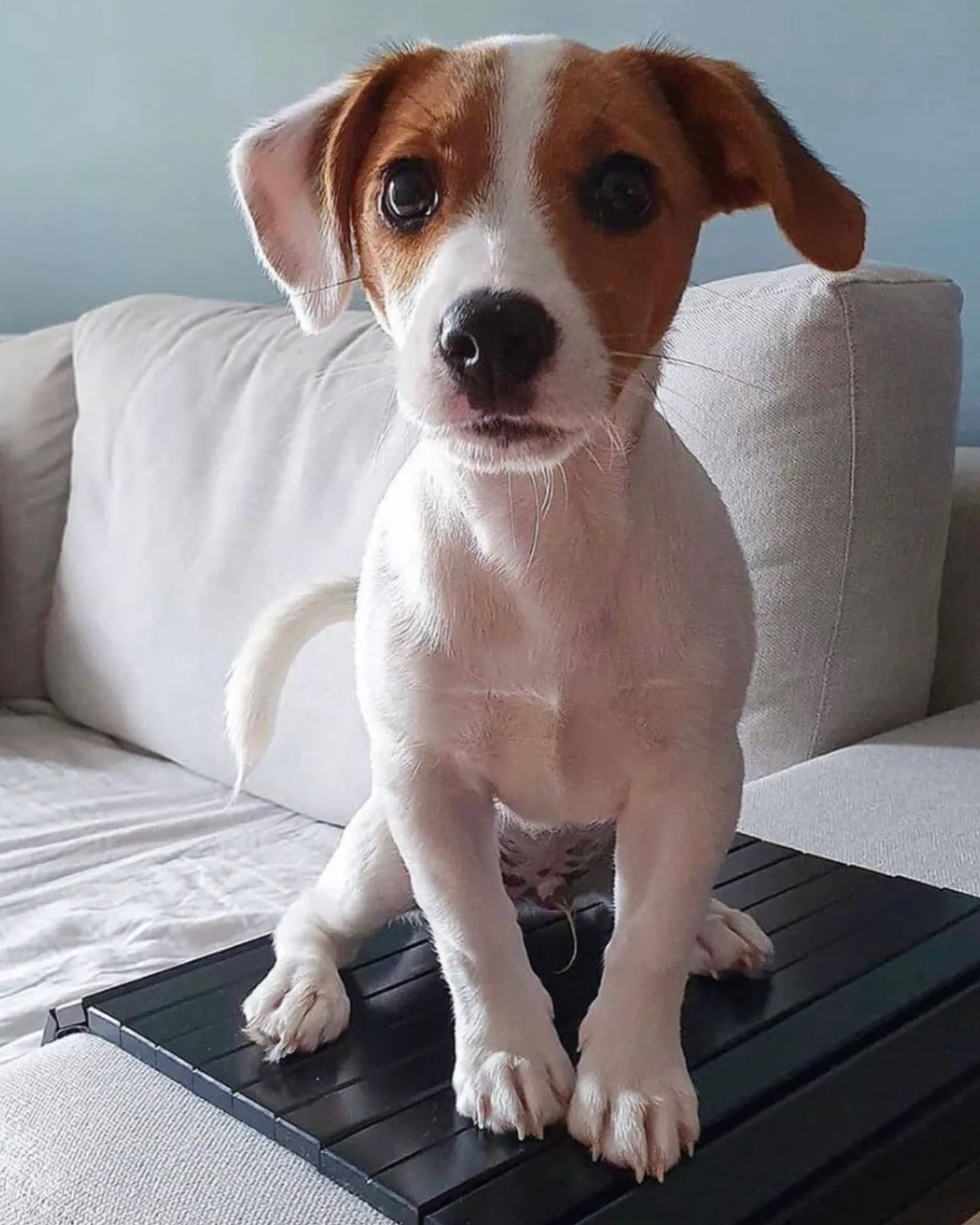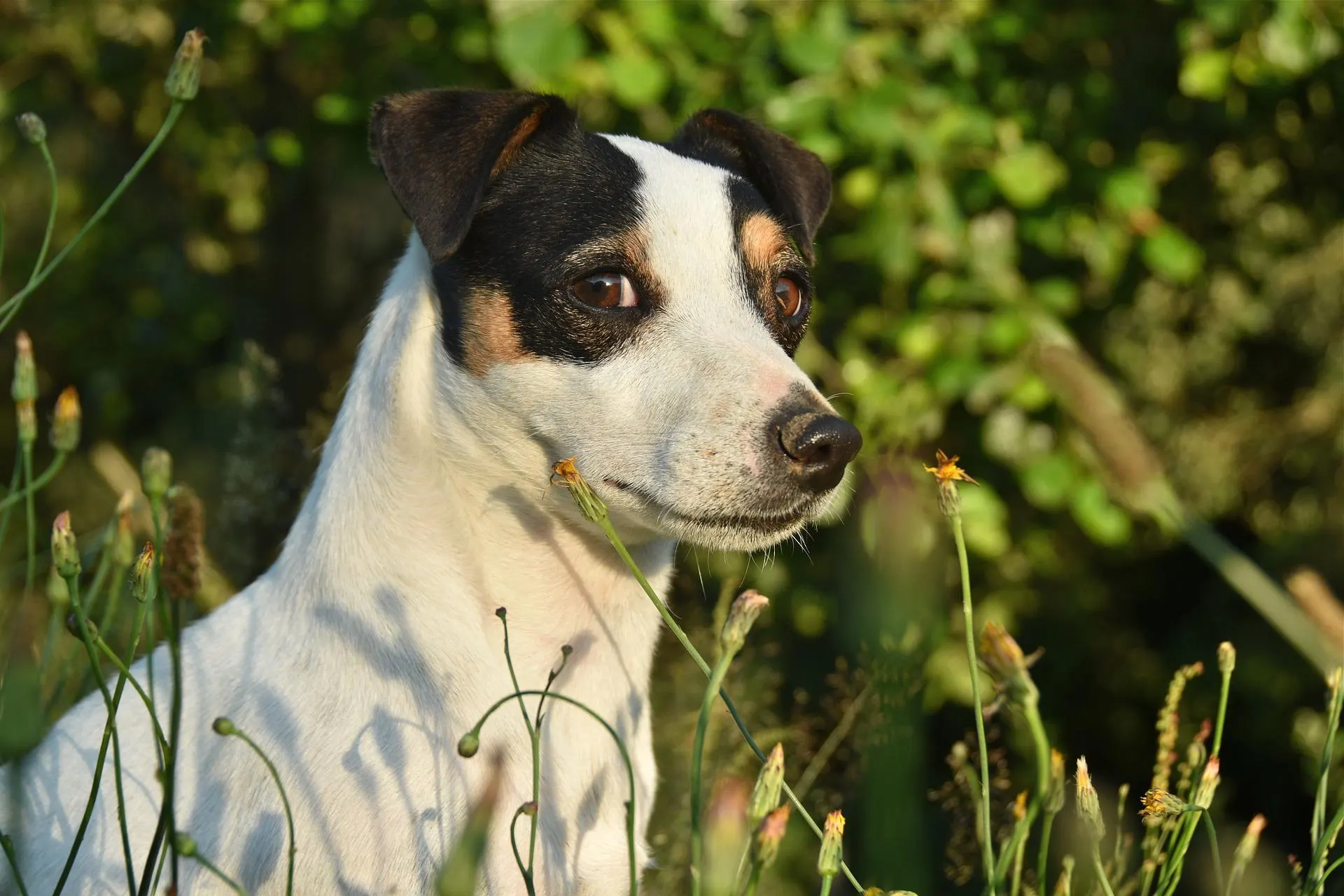The Jack Russell Terrier has many attributes that make him the perfect family dog, provided you have the time and patience to commit to him. He is loyal to and enjoys being with his people. Once he is fully matured, his background as a hunting dog makes him a superb jogging partner. His boisterous attitude can overwhelm younger children, but he will be a pleasant and affectionate playmate for active older youngsters
The Jack Russell might be the dog for you if you want a dog that can play fetch for hours on end, run an agility or flyball course in no time flat, learn tricks, and is a charming companion when he’s not up to trouble. No matter how adorable and tiny he is, he’s not the dog for you if you can’t handle a dog who will chew, dig, and bark, run through the house frequently, pursue cats and other small animals with delight and homicidal purpose, and always find the way around any command you give.
He’s an escape artist and would do best at a house with a yard and an impenetrable fence that can’t be scaled, dug under, or jumped. A JRT can’t be kept inside an underground electronic fence. Because of the Jack’s intense prey drive, you must always keep him on a leash when you are outside of gated areas. Additionally, because of his natural instinct to “go to ground” and dig for prey, your garden may become a target too.
If you want to learn more about this small but fierce dog breed, and see if he would be a good choice for you and your family, keep on reading.
History
The requirement for a small but tenacious fox hunting dog led to the creation of the Jack Russell terrier in England in the middle to late 1800s. A pastor by the name of John Russell recognized the need for a little terrier that could pursue the fox into the ground while foxhounds had grown in favor among England’s gentry for horse-and-hound hunting. He started a selective breeding program as a result, specifically to create a fierce yet small hunter.
The pastor appears to have been an enthusiastic hunter who sought to develop a fox hunting companion without anticipating that he would go on to become the creator of an entirely new breed. The most plausible conclusion is that selective breeding of English foxhounds and now-extinct white terriers led to the development of JRTs. The outcome was a breed of canines that were initially known as fox terriers, the designation that was applied to all fox hunting dogs of the time.
Many sportsmen, especially those who hunted on horses, came to love the Jack Russell. By the 1930s, the breed was well-known in the United States, and a number of breed clubs emerged, each with a distinct viewpoint on Jack’s looks, working aptitude, and suitability for confirmation displays versus continued use as a working dog.
The Jack Russell Terrier Club of America (JRTCA) applied for recognition by the American Kennel Club, which was awarded in 2000. The Jack Russell Terrier Club of America maintains an independent registry and views the Jack solely as a hunting dog. The American Kennel Club renamed the breed to Parson Russell Terrier in order to distinguish it from the dogs registered by the JRTCA.

Source: Instagram (@jackrussellhold)
Personality of the Jack Russell Terrier
The JRT is a lively, friendly dog with a lot of personality for such a small pup. He loves life and everything it has to offer. He is also loyal, funny, and loving. If he has even a small chance, he will follow what he wants through the streets and over fences. Even though he is very smart, his stubbornness can make him hard to train.
While he is friendly to people, he can be mean to other dogs and any other animal, including cats, that he might mistake for prey. When he decides to fight a bigger dog, his courage puts him in danger.
He does best with routines and structure, so training should be short and interesting to keep his attention. He is tired of hearing the same thing over and over again. When trained right, Jacks are always friendly and outgoing.
Like all other dogs, Jack Russells need to meet different people, see different things, hear different sounds, and do different things when they are young. Socializing your Jack Russell puppy is important if you want it to grow up to be a well-rounded dog.
If you can give a Jack Russell the care, training, supervision, and structure he needs, he may bring you a lot of joy and love. People who have never had a dog before or are afraid of them should start with a less demanding dog. Think carefully about whether this breed is the right one for you, so that both the dog and you will benefit. If so, get ready for a crazy but exciting ride.
Caring for Jack Russell Terriers
If you’re considering bringing a Jack Russell terrier into your home, be ready to put in the effort required to keep this energetic dog content and in good health. Although Jack Russell terrier puppies are almost too adorable for words, as they develop into active, athletic dogs, they demand a significant investment in terms of training, mental stimulation, and physical activity.
Being a people-pleaser, the Jack Russell should reside indoors with the family. The best option is for him to have access to a fenced yard where he can use some of his excessive energy. He shouldn’t be able to jump, climb, or dig beneath the fence. As for an underground electronic fence to keep your Jack in the yard, don’t bank on it. The threat of a shock pales in comparison to the need to pursue what appears to be prey.
To keep your JRT from pursuing other animals, sparring with larger dogs, or darting in front of moving vehicles, always walk him on a leash. To keep him worn out and out of mischief, give him 30 to 45 minutes of vigorous exercise each day in addition to lots of off-leash playtime in the backyard.
Jack Russell owners need to set clear expectations that they stick to. Jacks are independent-minded canines, and while they respond well to praise, play, and food rewards as positive reinforcement, they will become resistant to harsh punishment. But if you give your Jack Russell rules and routines, along with the correct amount of persistence and inspiration, you’ll reap the benefits. When with the right owner, a Jack Russell can learn anything.
Exercise
No talk about how to take care of a Jack Russell terrier would be complete without good advice on exercise. Even though they are small, these dogs need plenty of exercise. The JRT is different from most lap dogs. Even though they make great family dogs and love being with people, they were made to hunt. If you look at a dog that is only 10 to 15 inches tall but was bred to run with horses, you can get an idea of what kind of action these dogs want.
Depending on how old your JRT is, you should try to give it about 90 minutes of hard exercise every day. This should include many long walks. The little Jack Russell terrier makes a great running partner, which will surprise any runners who are looking for a dog. Also, it’s almost a must that your small terrier has a yard to run around in.
The JRT can jump as high as five feet, which is a great vertical jump. So, make sure that any enclosure is high enough to keep the animal from getting out. Also, keep in mind that these dogs are known for being great diggers, so be careful that digging accidents don’t turn into great terrier escapes.
The Jack Russell terrier does very well in go-to-ground trials and agility events. In the latter, this working breed goes through a tunnel course while being timed to see how fast and agile it is.
Training a Jack Russell Terrier
The Jack Russell terrier is easy to train because it is very smart. They are intelligent and can learn tricks quickly, but they can also be very mischievous. You need to set rules inside the house and teach your dog early on how to think about the order of things in a group. Obedience work can put the JRT’s mind and heart to the test in a big way.
This friendly dog, on the other hand, won’t like a rough touch or a bossy attitude. Instead, teach your JRT to work with you instead of against you by holding short, frequent training sessions and using positive reinforcement.
The perfectly trained Jack Russell you see on TV or in the movies doesn’t exist. It’s not easy to teach a Jack Russell how to be a good boy. It takes a long time, a lot of patience, and a sense of humor. The JRT is pretty easy to train, but he has his own ideas and won’t stand to be bored. If you don’t keep him busy, he’ll find his own things to do, and you probably won’t like what he does.
As we already explained, socialization is an important part of your dog’s training as well. They can have a hard time around other animals, so you should start introducing him to other dogs or cats as early as possible. Ideally from when he is a puppy.
Grooming
Taking care of a Jack Russell terrier is rather easy. The short coat is simple to comb to get rid of stray hair, and a periodic bath will keep dirt and dander in check. There are two coat varieties available for the Parson Russell Terrier: wired and smooth. Both varieties have a thick double coat on top. The wired coat is significantly longer and has a beard and just a hint of eyebrows.
White, white with black or tan patterns, or tricolor (white, black, and tan) are the most common colors. Only a weekly brushing is required for both coat types to get rid of loose and dead hair. If you reguraly brush your Jack, he shouldn’t frequently require a bath. Once or twice a year should be enough.
Once or twice a month, trim your dog’s nails. They are too lengthy if you can hear them clicking on the floor. Short, well-trimmed nails preserve the feet in good shape and prevent scratches when your Jack jumps up to meet you with enthusiasm.
Now, let’s talk teeth. Just like with any other dog breed, you will have to brush their teeth. Once a day would be ideal, but a couple of times a week will still get rid or build-up and prevent dog dental problems.
And finally, make sure you also clean the ears of your dog. You don’t have to do this too often, but make sure you clean them with a cotton ball and a cleaning solution at least once every month or two. This will help prevent ear infection, and keep his ears in great shape.
Health
Although Jack Russell Terriers are typically healthy, they are susceptible to some health issues like all breeds. It’s crucial to be aware of these diseases if you’re thinking about getting a JRT. Find a reputable breeder who will provide you with the health clearances for both of your puppy’s parents if you are purchasing a puppy. Health certifications attest to a dog’s having undergone testing and receiving a clean bill of health.
The most common health conditions in JRT are:
Legg-Calve-Perthes. This disease typically affects small dog breeds. It leads to painful arthritis and loss of mobility. It is treatable surgically, and the prognosis is good with the aid of postoperative physical therapy.
Deafness. This condition is occasionally observed in this breed and is linked to white coat color.
Patellar luxation. There are four levels of patellar luxation. Grade I only temporarily impairs the joint. Grade IV is where the tibia is severely turned and the patella cannot be manually straightened. The dog appears to have bowlegged legs and it’s difficult for them to walk. Surgery may be necessary to correct severe grades of patellar luxation.
Glaucoma. This is a painful condition in which the pressure inside the eye is unusually high. The optic nerve is harmed by that intense pressure, which causes blindness and visual loss. Usually, only one eye is affected by glaucoma at a time. Affected eyes will appear painful, be red, teary, and squint. Depending on the situation, the treatment may involve surgery or medication.

Conclusion
The JRT is a great choice for people looking for a small but feisty canine. These dog may be small, but they have the biggest personality. They aren’t the best choice for first-time dog owners, but if you have experience with hunting breeds, go for it.
These puppies are very intelligent, however, don’t assume that they are easy to train. They are stubborn like no other, and easily get bored. You have to use positive reinforcement and make training sessions fun.
But if you are willing to give these dogs everything they need, you won’t be disappointed. They form close bonds with their owners, and make amazing companions. They are very protective and will be there for you no matter what.

